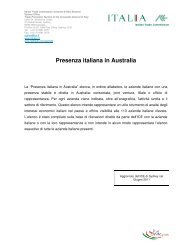Price Determination in the Australian Food Industry A Report
Price Determination in the Australian Food Industry A Report
Price Determination in the Australian Food Industry A Report
You also want an ePaper? Increase the reach of your titles
YUMPU automatically turns print PDFs into web optimized ePapers that Google loves.
Figure 96. Consumer price <strong>in</strong>dex, food and eggs, 1996–2002<br />
Index<br />
170<br />
160<br />
food<br />
150<br />
140<br />
130<br />
120<br />
eggs<br />
110<br />
December 1996 December 2002<br />
Source: <strong>Australian</strong> Egg <strong>Industry</strong> annual statistics 2002<br />
• The low price of eggs has been achieved through a comb<strong>in</strong>ation of factors <strong>in</strong>clud<strong>in</strong>g:<br />
– <strong>the</strong> pass<strong>in</strong>g to consumers of <strong>the</strong> benefits of <strong>the</strong> gradual consolidation of <strong>the</strong> <strong>in</strong>dustry <strong>in</strong><br />
production and pack<strong>in</strong>g sectors; and<br />
– <strong>the</strong> use of supermarket brands to compete with <strong>in</strong>dependent operators who face lower<br />
cost regimes than <strong>the</strong> emerg<strong>in</strong>g major suppliers of supermarket and proprietary brands.<br />
Retail versus farmgate prices over time<br />
The comparison of retail and farmgate returns over time is as follows.<br />
Figure 97. Retail and producer prices for eggs, cents/dozen, 1996–2003<br />
cents<br />
450<br />
400<br />
350<br />
retail<br />
300<br />
250<br />
<strong>Price</strong> <strong>Determ<strong>in</strong>ation</strong> <strong>in</strong> <strong>the</strong> <strong>Australian</strong> <strong>Food</strong> <strong>Industry</strong> A <strong>Report</strong><br />
200<br />
150<br />
100<br />
50<br />
0<br />
producer<br />
1996–97 1997–98 1998–99 1999–00 2000–o1 2001–02 2001–03<br />
Source: <strong>Australian</strong> Egg <strong>Industry</strong> annual statistics 2002<br />
The farmgate numbers above are based on <strong>in</strong>dustry estimates.<br />
The rise <strong>in</strong> both values <strong>in</strong> 2003 was due to <strong>the</strong> effects of drought, where <strong>the</strong> egg marketers set<br />
higher sell<strong>in</strong>g prices (about 30c per dozen at wholesale) to assist <strong>in</strong> recover<strong>in</strong>g <strong>the</strong> sharp <strong>in</strong>crease<br />
<strong>in</strong> <strong>the</strong> cost of feed gra<strong>in</strong>. Retail prices rose by a larger amount.<br />
The sharp rise <strong>in</strong> feed costs has not yet been reversed <strong>in</strong> production cost structures. It is expected<br />
that <strong>the</strong> full cost of greater future security of feed gra<strong>in</strong> supply to <strong>the</strong> poultry <strong>in</strong>dustry will see feed<br />
costs do not return to reliable pre-drought levels.<br />
90







